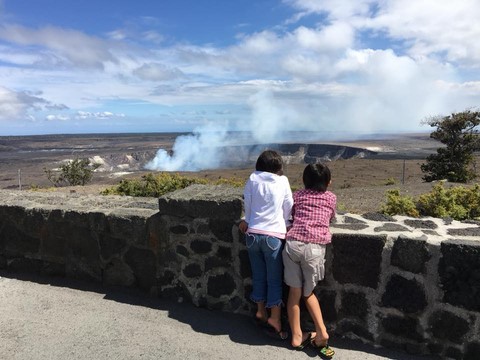Hawaii Volcanoes National Park - News

STAY SAFE WHEN VISITING!!
Any eruption at the summit of Kīlauea volcano is drawing thousands of visitors to Hawaiʻi Volcanoes National Park eager to see the plume of gas and steam by day and the lava glow after dark.
The park is open 24 hours a day, and the public is reminded to stay safe by following these precautions:
• • Volcanic eruptions can be hazardous and change at any time. Stay on marked trails and overlooks, and avoid earth cracks and cliff edges. Do not enter closed areas.
• Hazardous volcanic gases are billowing out the crater and present a danger to everyone, especially people with heart or respiratory problems, infants, young children and pregnant women.
• Slow down and drive safely. Expect long waits for parking spaces at popular vantage points like Uēkahuna (formerly the Jaggar Museum).
• At 1,219 meters, (4,000 feet), the summit of Kīlauea can be chilly at any time. Bring a rain jacket, wear long pants and closed-toe shoes. Bring a flashlight if visiting at night.
Where’s the Lava when Kilauea is erupting?
What visitors can expect to see in Hawaiʻi Volcanoes National Park
Hawaii National Park, HAWAI‘I – Captivating images and video of the new lava lake eruption on Kīlauea volcano can go viral, but they often do not represent what visitors can safely see when they visit Hawaiʻi Volcanoes National Park.
So what can visitors expect to see? It depends on when they arrive, and the weather.
In the Dark. A magnificent reddish orange glow fills the dark sky above a massive 127-acre (52 hectare) lava lake, reflecting into the gas plume wafting out of the volcano, and onto any clouds above the summit crater, Halemaʻumaʻu. Jagged crater walls are illuminated, showing the scars from the 2018 summit collapse.
In Daylight. Volcanic gas and steam billow out of Halemaʻumaʻu, and the entire summit caldera, Kaluapele, is fully visible. Koaʻe kea, white-tailed tropicbirds, are often observed flying above the crater.
The best eruption viewpoints day or night are along Crater Rim Trail, and include Uēkahuna, Kīlauea Overlook, Wahinekapu (Steaming Bluff), Kupinaʻi Pali (Waldron Ledge), Keanakākoʻi and other overlooks. Glimpses of lava from the rising lava lake were spotted periodically from Keanakākoʻi and Uēkahuna last night and today. Please note there is limited parking at Devastation Trail parking lot, used to access Keanakākoʻi.
Check the Weather. Rain and clouds are not uncommon at Kīlauea, and conditions can change quickly. The 4,000-ft. (1,210-m) summit can also be chilly.
Safety First. Volcanic eruptions can be hazardous and can change at any time. Stay on marked trails and overlooks, and avoid earth cracks and cliff edges. Do not enter closed areas. Maintain social distance of six feet and wear a mask to reduce the spread of COVID. Stay home if you are feeling sick.
Be Respectful. Park landscapes are sacred places for many people. Please be respectful and allow them to practice their traditions privately.
The current eruption is just one feature of Hawaiʻi Volcanoes National Park, a revered landscape and a World Heritage Site that spans 335,259 acres from sea level to the summit of Mauna Loa volcano.